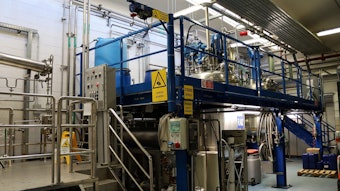Computer-aided engineering (CAE) is the enabling of a comprehensive analysis environment across the entire range of products and associated processes. CAE encompasses several components: computer rendering of product geometries via tools such as computer-aided design (CAD), computational structural dynamics (CSD) and computational fluid dynamics (CFD). These tools facilitate the rendering, visualization, analysis and selection of different candidate products or processes before conducting any lab or plant scale trials. Hence, the concept of virtual prototyping of the engineering processes in the cosmetic industry evolved in the late 1990s—driven by the demands of quality, cost and time-to-market.
Most products in the cosmetic industry are liquids, emulsions, aerosols, powders and crystals, and the manufacturing processes are significantly dominated by fluids of different configurations.1 Thus, virtual experimentation in cosmetic product manufacturing and performance analyses involves computer simulation of fluid flow physics, chemistry and even advanced issues such as surface chemistry, electrostatics, granulation, dermatology and epidemiology. Such virtual tools are enabled within the scope of CFD.
CFD is complementary to the experimentation and testing techniques traditionally used to develop and manufacture a product. An upstream CFD analysis often optimizes subsequent pilot plant trials as well as scale-up. It also helps in the product development process to rule out unfeasible designs and identify problems before actual trials. Apart from being nonintrusive and not requiring construction of any physical equipment or test lines, CFD offers both qualitative and quantitative insight into flows or equipment where testing is difficult or impossible.
Engineering Challenges in Cosmetics and Toiletries
Cosmetic products often require chemists’ formulations to be tested on target skins and other physiological entities, such as hair and nails. There are corresponding manufacturing issues as well—scale-up, packaging, delivery mechanisms and cost optimization. Proper mixing of ingredients, often with complex material properties, is critical to the final product quality. For many products, this may require understanding of mixing behavior on multiple scales—micromixing, mesomixing and macromixing.
Additional challenges are faced when mixing applications involve crystallization, solids suspension, powder mixing and liquid-liquid mixing.
CFD has been used to help to understand fluid flow phenomena in many types of equipment where these processes take place (mixers, emulsifiers and crystallizers for example) and, in addition, that phenomena in the packaging materials that eventually will contain product.
Analysis of Solids Suspension in a Liquid Medium
Mechanical agitation is widely used in cosmetic industry operations involving both liquid-liquid and solid-liquid flows. In cases of solid suspensions in liquid media, the typical process requirement is for the solid phase to be suspended such that the suspension either is self-sustained or requires minimal shaking by the end-user. The issues are dissolution and any plausible reaction rates, as well as feed uniformity. The challenge is in understanding the fluid dynamics in the vessel and relating this knowledge to design through adjustable process parameters.
The motivation of this study is to elucidate the criteria of minimum suspension speed using CFD to establish scale-up criteria for stirred tanks suspending solids. One critical parameter for such solids-in-liquid system is the “just-suspended” speed (NJS). However, designing based on only NJS or on power draw does not necessarily lead to an optimum design. The impeller system has to be designed to provide optimum flow pattern for the suspension duty. As such, numerous correlations exist for NJS. Some of the correlations were developed with a narrow range of impeller blade styles, sizes and position in the lab scale tank. Due to the large variability involved, the prediction of NJS by means of correlations is often questionable. Thus the objective of CFD modeling is to predict NJS, solids distribution, cloud height, amount of solids unsuspended and the scale-up criteria.
Analyzing In-line Static Mixer Performance
Compared to the stirred tanks, static mixers operate in continuous mode. Several varieties and generations of static mixers are used in the cosmetics and toiletries industry.2–5 Static mixers are used predominantly for homogenization with relatively gentle shear forces such that the fluids are sheared locally to mix through intersecting flow channels by continuous splitting, extension and transport. Variations in concentration, temperature and velocity are equalized over the flow cross-sections in the mixer elements. Mixing is not random but follows the geometric pattern of these elements.
The engineering objective of static mixer flow analysis is to quantify the state of mixing by a parameter called the “coefficient of variation,” which typically is used to estimate the macromixing and determine the minimum number of elements required for a given unit operation. Gathering clear experimental pictures at various sections of a static mixer is expensive and not always feasible, whereas parametric variations in geometry, number of elements, flow conditions and fluid properties are easily studied using CFD.
Simulation data can be used to determine pressure drop, power requirements and the minimum number of elements needed to attain the required mixing uniformity.5 Time and money are saved through the use of CFD to determine these parameters before construction of an experimental apparatus.
Making a Case for the Return on Investment
The use of CFD to understand the performance of equipment and products at a level of detail that would be difficult or impossible to gather through physical experimentation is gaining momentum in the industry. Further use caters to the optimization of process lines and unit operations. By strategic deployment of this tool in these areas, product innovation is enhanced through reduced time-to-market, allowing for more time to be spent on the creation of new or re-designed products—leading to the reliable production of more optimal or “perfect” products. Despite its obvious potential, an eye-opener in the form of demonstrated cost and effort savings is needed to justify the use of the tool on an ROI basis.
For example, the process line for web coating at Armstrong operated at 40 feet per minute with air pressures of 6 psi, while the production line needed to be operated at 125 feet per minute. However, no reliable scale-up laws existed to determine the nominal blower pressure needed for the production line or the maximum blower pressure required for the entire range of expected operating conditions.
To answer these questions, Armstrong zoomed into the process line and identified the area where analysis was needed the most. First, a CFD simulation of the pilot line was performed to establish the validity of the numerical modeling results. A comparison of the CFD results with the plant measurements indicated the predictions were accurate to within 10% of the plant data. Thus, engineers at Armstrong were able to confidently use CFD to perform parametric studies of the production line behavior over 175 different combinations of operating parameters. The amount of testing time needed for the production line was reduced from 35 weeks to two weeks, and the final design was completed ahead of schedule with a significant reduction in costs.
Armstrong was able to derive additional benefits in product quality from the results by developing a PC-based controller based on curve fits from the simulation and pilot plant data that allowed operators on the line to key in changes in feed condition, line speed and air pressure and allowing them to instantly know the effect of these parameters on the resulting product.
Understanding the performance of cosmetic products
The CFD model in this case consists of several strands of hair very close to the scalp.
In the first example, a comparison is made of the removal of a mixture of grease and dirt from the hair using water and then a water/shampoo mixture. The dirt/grease is modeled as a viscous liquid. At the start of the simulation, droplets of dirt/grease are present on the hair. An initial simulation was performed using pure water only, which does not affect the dirt/grease surface tension or contact angle. The two images in Figure 3, taken from the beginning and end of the simulation, show that very little dirt/grease was removed.
A second simulation was performed using a flow of water/shampoo mixture (containing the 2% detergent). Because the detergent lowers the surface tension of the dirt/grease, the flow of shampoo/water is very effective at removing the dirt as shown by the images in Figure 4, which represent several snapshots in time from the CFD simulation.
In the second example, a simulation is performed of the time-dependent wicking/penetration of a medication (antidandruff agent, for example) into the scalp as it is delivered in a shampoo/water mixture. The concentration of medication in the shampoo/water mixture is assumed to be 1%. Such rudimentary models can be used to obtain a better understanding of the roles of diffusion; convection and capillary effects on the cleaning and delivery effectiveness of various hair-care products.
Through these examples and an analysis of the market factors driving this industry, it is shown that the use of CFD can help companies create more optimal (or “perfect”) products by helping to reduce time-to-market by reducing the time required for physical testing while providing a high level of return on investment, by understanding how unit operations in process equipment affect product quality and by gaining insight into product performance.
The resulting knowledge, as well as the savings in time and cost gained through CFD, will provide greater opportunity for product innovation, thus strengthening the competitive position of companies that use this technology.
Acknowledgements
The authors would like to thank Armstrong Inc. for its approval to share the CFD success story. The authors also would like to acknowledge contributions from their current and former colleagues at Fluent, Andre Bakker, Liz Marshall, Lanre Oshinowo, Ahmad Haidari, Eric Grald and Rafi Khan.
References
- WM Gelbart and A Ben-Shaul, The “new” science of “complex fluids,” J Phys Chem 100 13169–13189 (1996)
- KJ Myers, A Bakker and D Ryan, Avoid agitation by selecting static mixers, Chem Eng Prog 28–38, (June 1997)
- A Bakker, RD LaRoche, EM Marshall, “Laminar Flow in Static Mixers with Helical Elements,” www.bakker.org/cfmbook/lamstat.pdf
- “Design Modification to SMX Static Mixer,” S Liu, A N Hrymak and PE Wood, AIChE Annual Meeting No. 364c, Laminar Mixing and Mixing Fundamental Session(2003)
- S Liu, AN Hrymak, P Wood and R Khan, “Static Mixers by Design,” www.fluent.com/about/news/newsletters/02v11i1/a6.htm










